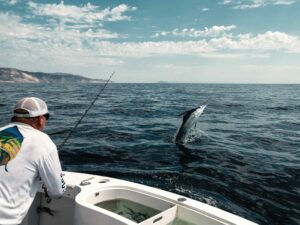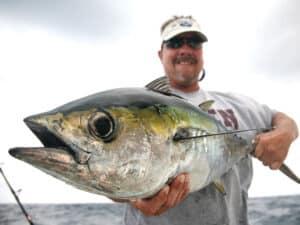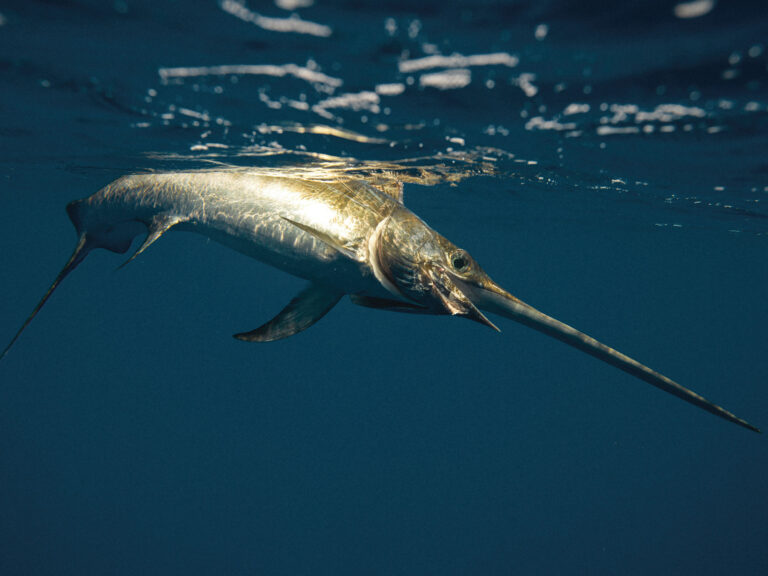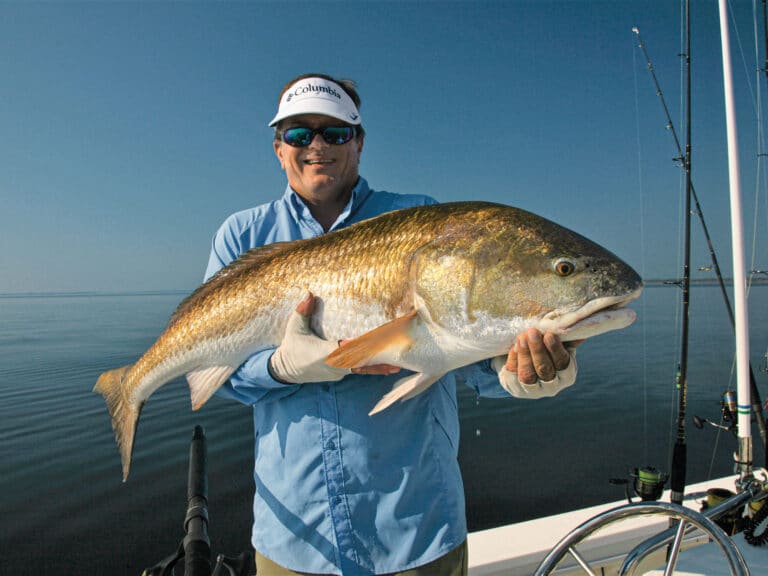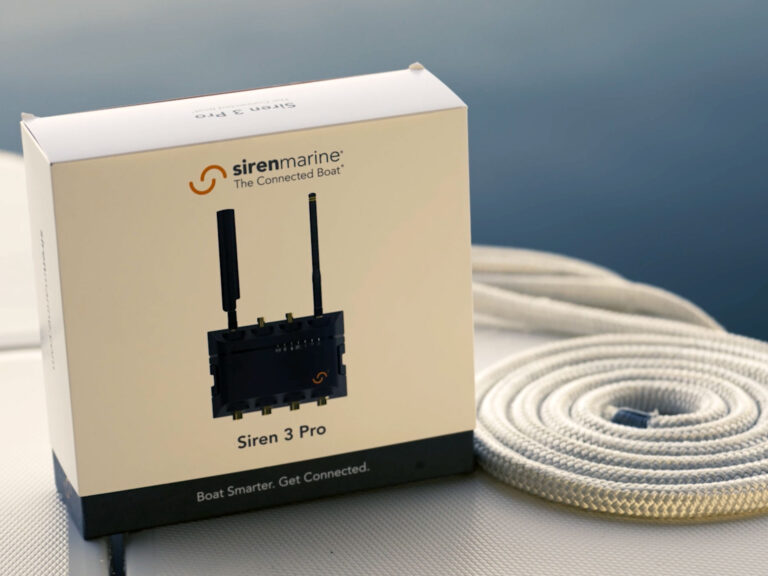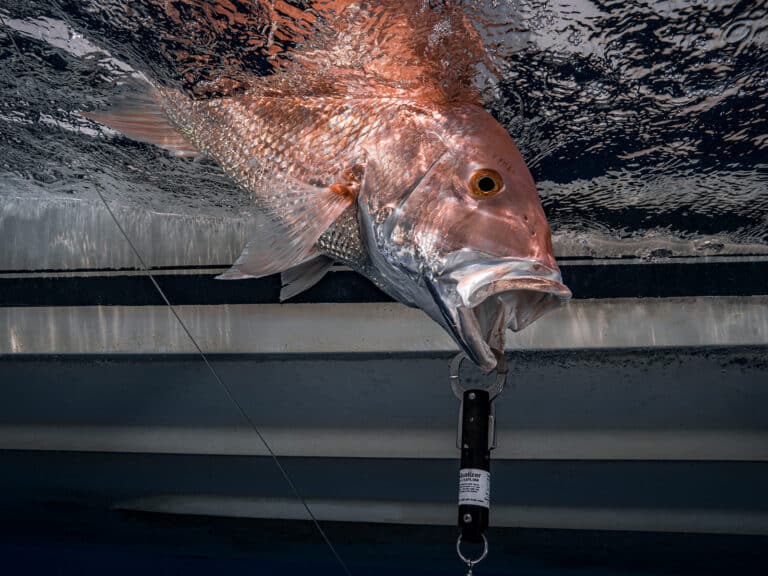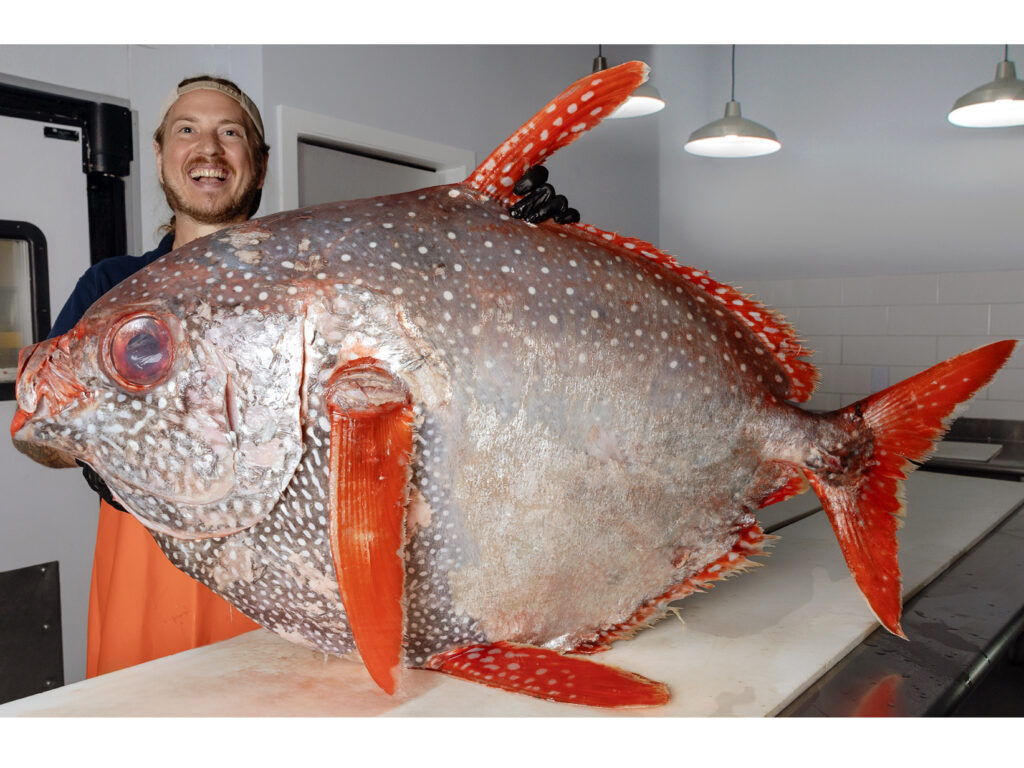
The opah, also known as moonfish (Lampris guttatus), has a remarkable distinction in the marine world: it’s the only known fish that is fully warm-blooded. While fish like tuna and certain sharks are locally warm blooded, opah maintain an elevated temperature throughout their entire body, including the heart and brain.
This warm-blooded trait, known as whole-body endothermy, gives the opah a powerful advantage in deep, cold ocean environments. It’s made possible by the fish’s fascinatingly unique gill design. It uses a counter-current heat exchange system where warm blood from the body heats up cold blood returning from the gills, minimizing heat loss. This allows opah to swim faster, react quicker and see better than other fish at similar depths, making it a stealthy and efficient predator. The moonfish’s full-body endothermy was discovered by NOAA scientists in 2015. The realization rewrote what we thought possible for fish physiology—and secured its place as one of the ocean’s most fascinating species.
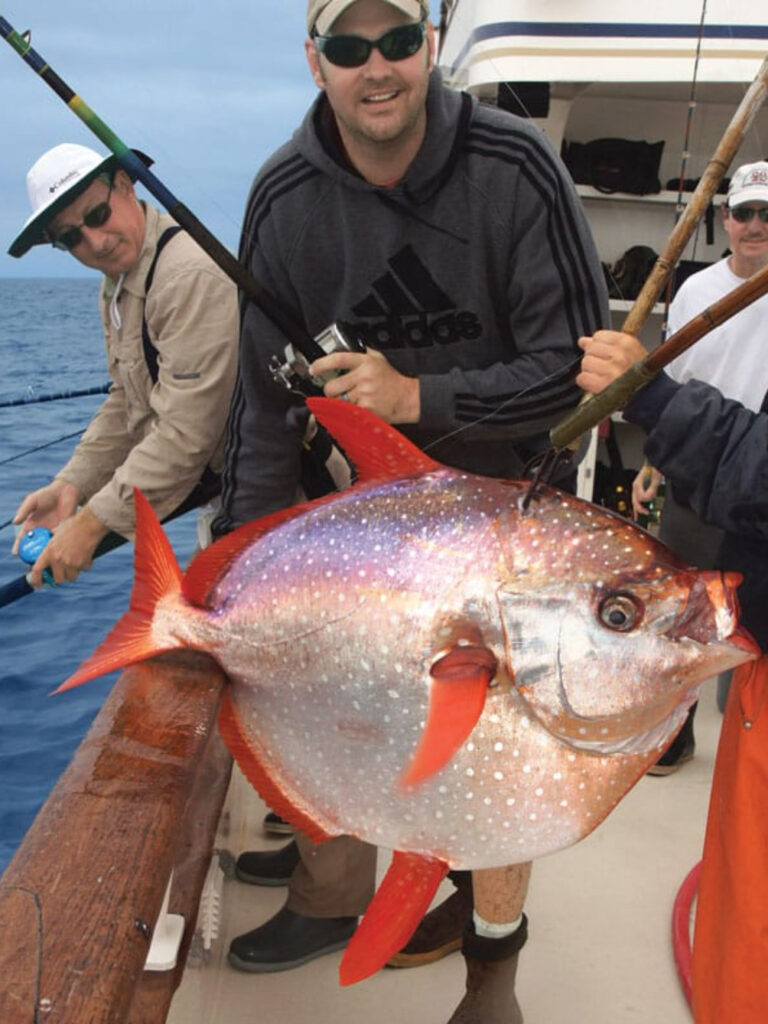
Habitat and Distribution
The opah is a captivating species sought after by both commercial and recreational fishermen. These fish inhabit temperate and tropical oceans worldwide, including regions around Hawaii, the eastern Pacific near California, and the North Atlantic. They typically dwell at depths ranging from 150 to 500 feet, often venturing deeper during daylight hours and ascending closer to the surface at night.
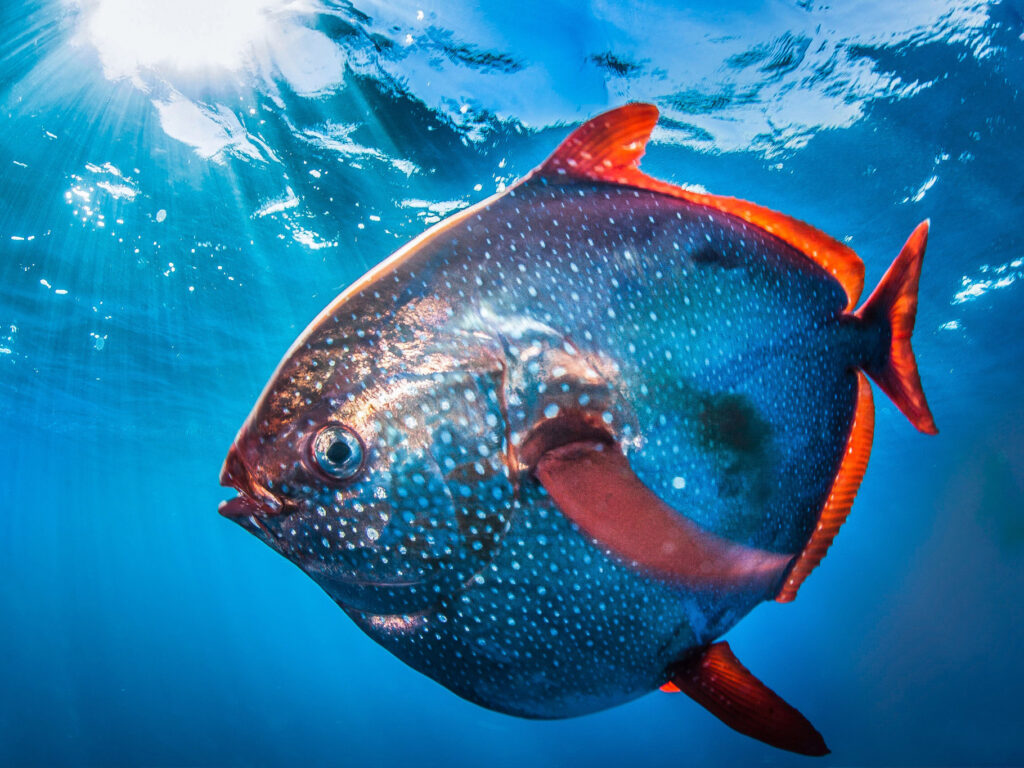
Fishing for Opah
Commercially, opah are primarily caught as bycatch in longline fisheries targeting tuna and swordfish. In Hawaii, for instance, deep-set longlines intended for bigeye tuna frequently yield moonfish. Despite not being the primary target, opah have become a valued component of these fisheries due to their distinctive taste and texture.
Opah meat is like wahoo meets yellowfin tuna, and it’s absolutely incredible! For recreational anglers, landing an opah is a rare and prized event. These fish are known to inhabit deeper offshore waters, making encounters infrequent. Anglers fishing for opah often focus on areas where these fish are known to co-occur with species like tuna.
Unfortunately, opah’s solitary nature makes targeting them difficult. If you’re lucky enough to come across this incredible fish, you’ll want to get every drop of meat!
How to Fillet Opah
The odd shape and swimming style of moonfish makes breaking them down for the table a little different from run-of-the-mill species. Most fish rely on their tail for locomotion. Moonfish flap their long pectoral fins like wings to move through the water. This builds strong muscles of delicious dark meat that should be removed with care following the steps below.
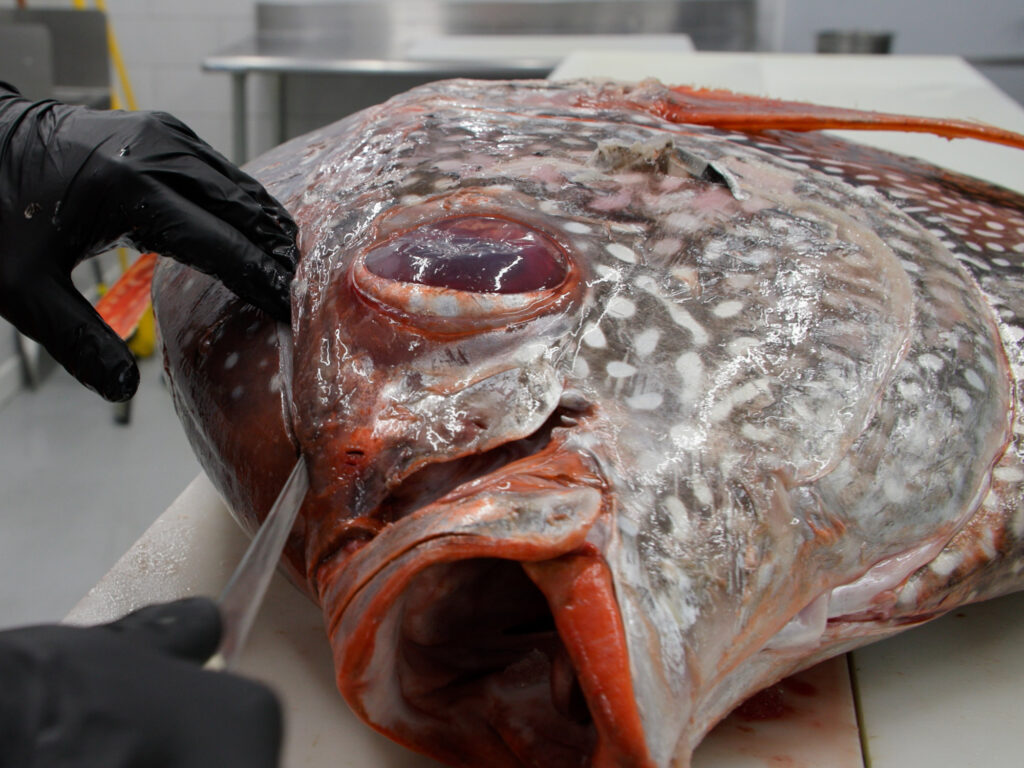
Initial Cuts
First, cut behind the head. Just like big bull mahi, opah have a huge chunk of delicious tender meat behind the head. When making this initial cut, angle your knife toward the inside of the head to cut underneath the bone.
If you cut straight down, you’ll miss out on the meat underneath the bone. Lift the pectoral fin, feel the bone underneath it, and follow that bone behind the head.
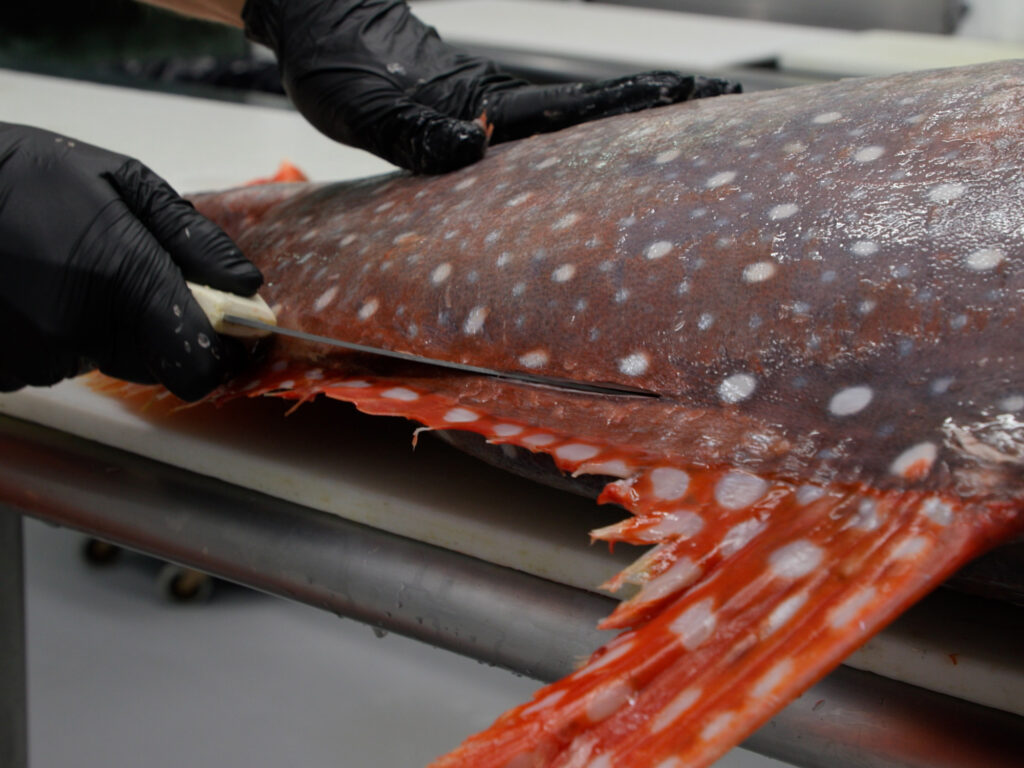
Outline the Opah
Next, outline the outside of the body with your knife. There’s a great starting point at the top of the dorsal fin. Insert your knife there and slide down to the tail. Let the big backbone guide your knife.
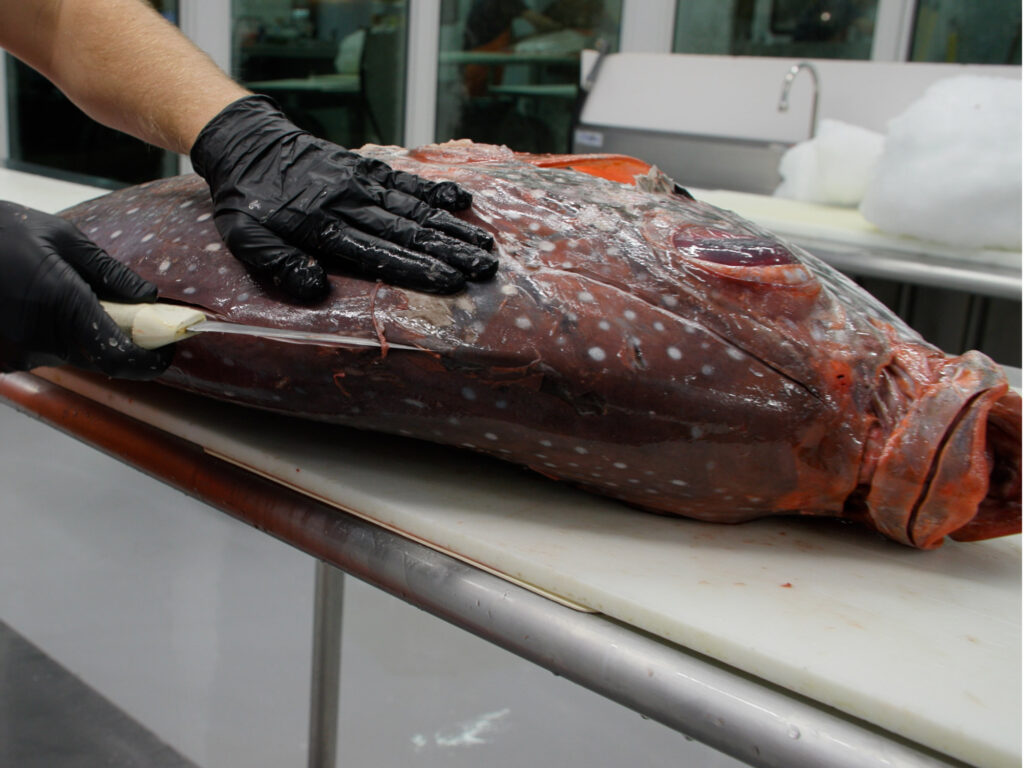
Work to the Spine
After establishing a nice starting point, working your way to the center spine is easy. Let the Opah’s skeleton guide your knife.
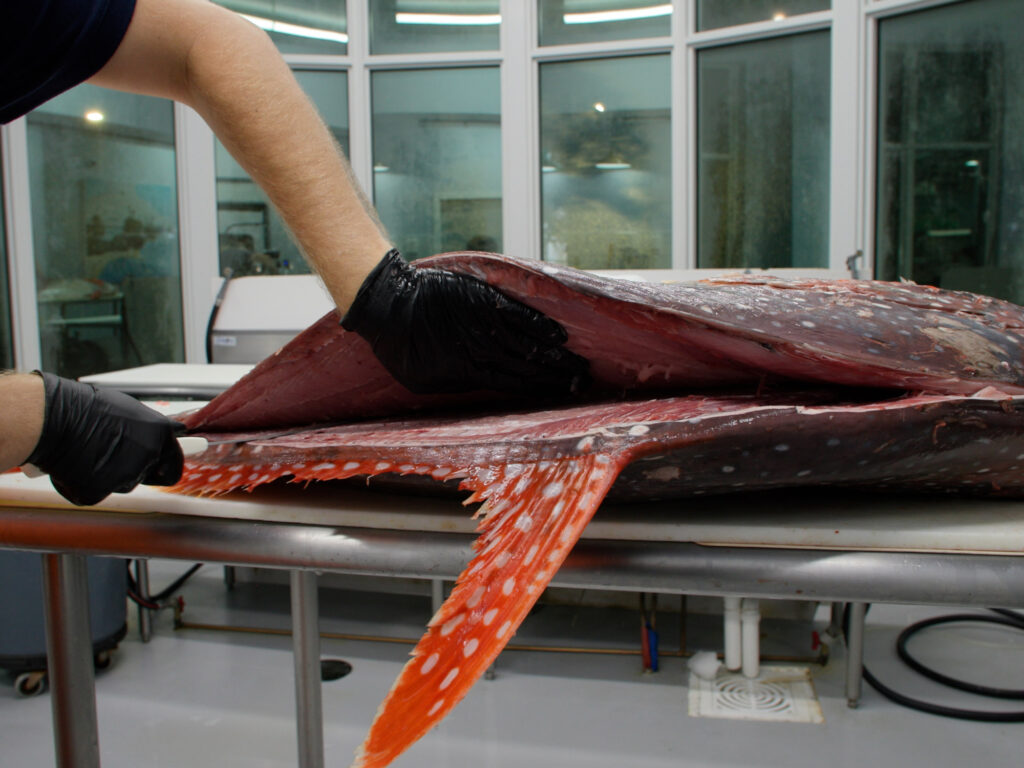
As you open the opah up, be careful while lifting on the heavy fillet. The meat is very tender, and handling it with too heavy of a hand can easily leave fingerprints in the meat. To prevent this, keep your hand open to disperse the fillet’s weight.
Navigate the Ribs
While lifting on the head portion of the fillet, use just the tip of your knife at a slight upward angle to separate the connection the pin bones make to the ribs.
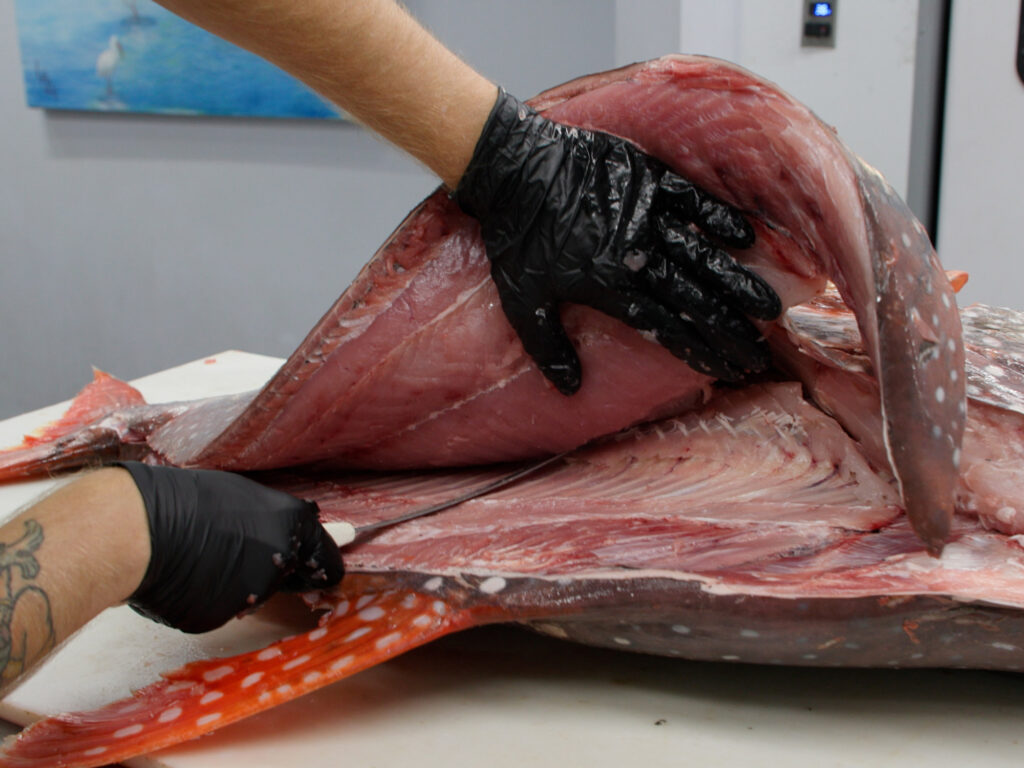
Now you can work your way over the rib bones and fillet the low loin on the other side of the spine. Or you can work from where you removed the head meat and make a cut along the inside of the collar to the belly between the dorsal and anal fins. At that point, rotate the fish and begin working upward using the skeleton as your guide to remove the low loin.
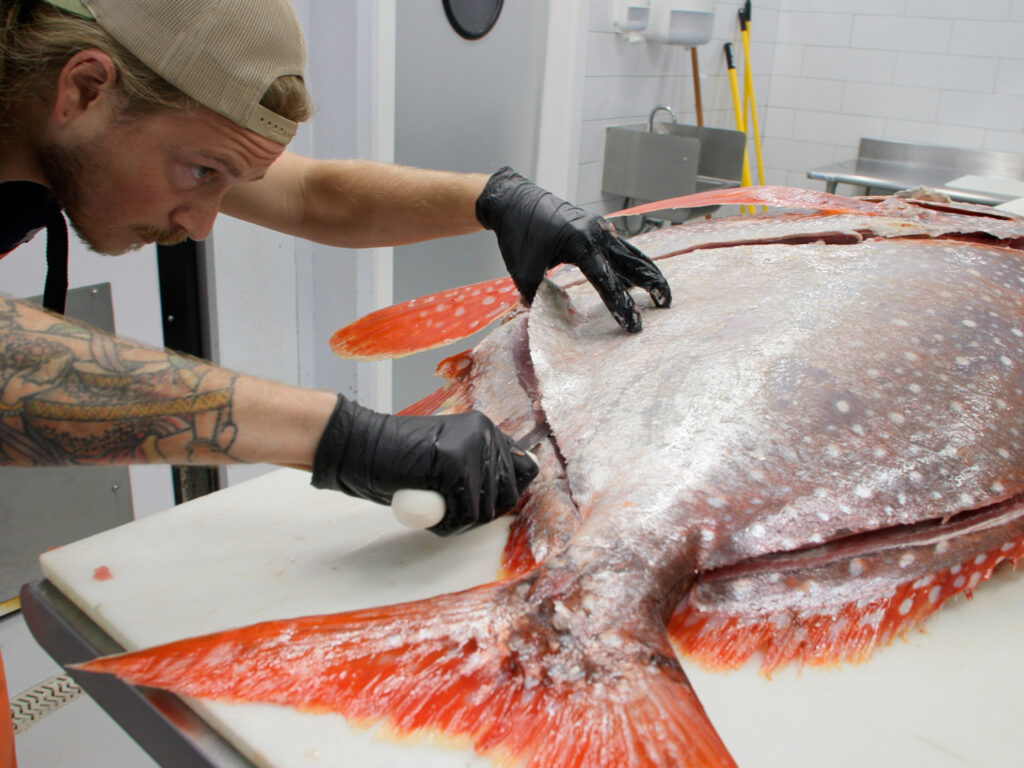
Opah Dark Meat
Now to the fun part—removing the dark muscle meat, also known as the abductor muscle. This muscle is responsible for the elevation and outward movement of the pectoral fins. This muscle is pronounced on opah because of their odd swimming style, which utilizes wing-like pectoral fins more than the tail. Cutting this muscle out is straightforward because it’s surrounded by bone that you outline, similar to cutting out cheek meat, only a hundred times larger, and the meat is red.
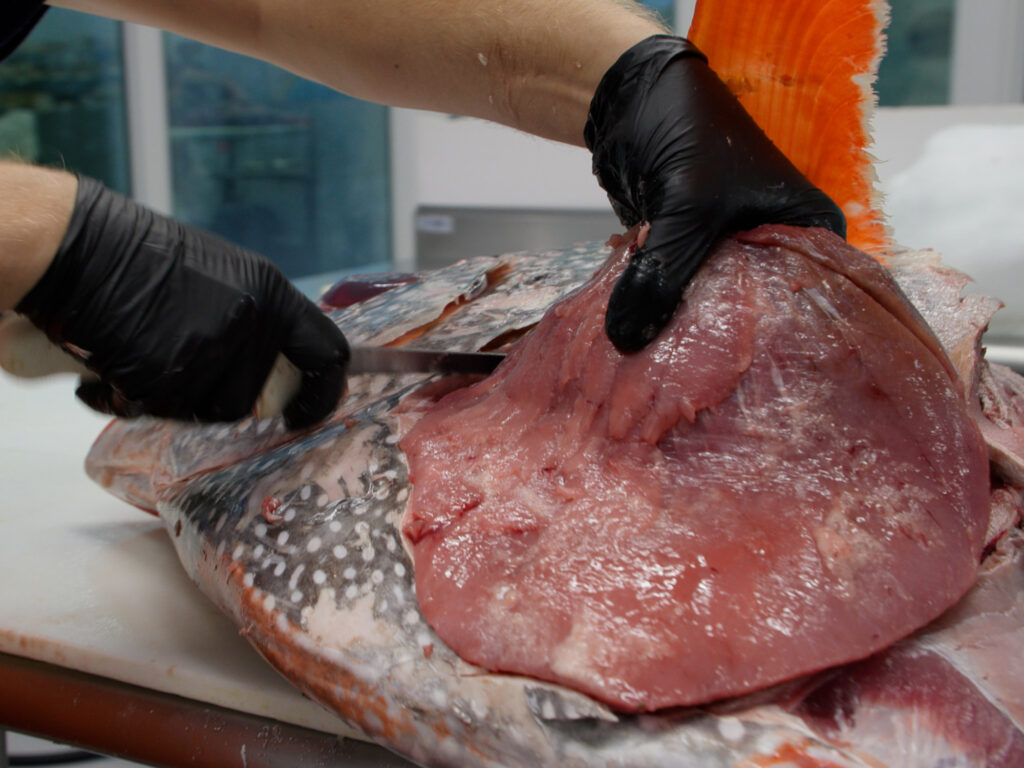
The Other Dark Meat
Next, pulling out the second red meat cut—the adductor—is a little more challenging. The adductor muscles are located on the medial (inner) side of the pectoral fins. Their primary function is to pull the pectoral fins inward toward the body, facilitating precise control during swimming. This action complements the outward movement driven by the abductor muscles, enabling the opah’s distinctive flapping motion of its wing-like pectoral fins. This continuous fin movement is essential for propulsion and maneuverability.
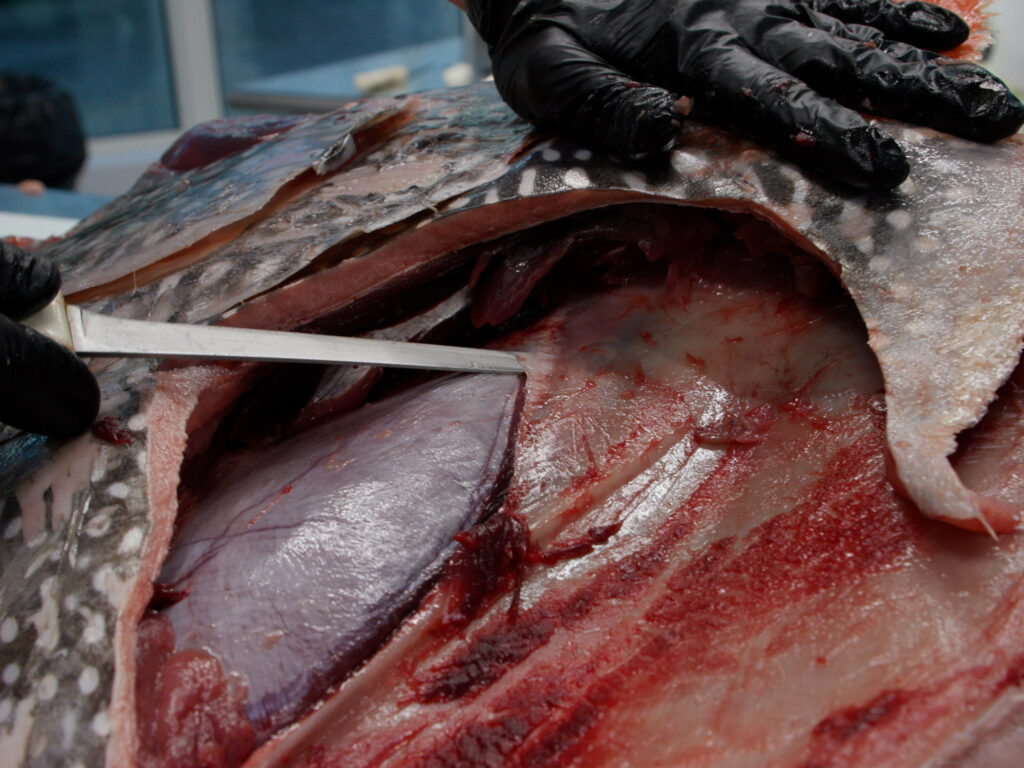
To cut it out, use the tip of your knife to go underneath the bone that encompasses the abductor muscle and outline the muscle with your knife. After carving the outline, you can get a little more access to the muscle and cut it out. These two dark muscle meats are just as good as top-shelf lean tuna!
Bonus Tip!
Do not forget to take a spoon and scrape the backbone. The meat along the skeleton is phenomenal for tartare and poke.
What Makes a Good Fillet Knife?
Reed Brand, the Fishmonger, knows a thing or two about fillet knives. He uses a Dexter 7-inch flexible fillet knife for almost every cut he makes at Captain Clay & Sons Seafood Market in Delray Beach, Florida.
Brand uses a serrated blade to saw bone when cutting steaks, but a flexible, 7-inch, straight blade with a grippy handle is his tool of choice for almost every other application.
5 High-Quality Fillet Knives
There are a lot of good fillet knives on the market. Here are a few quality knives to begin the search.
• The AFTCO 8-inch Flexible Fillet Knife has a full-tang Böker German stainless-steel blade with AFTCO’s gold tin finish. It was designed to retain sharpness and resist corrosion, and the textured polypropylene handle is slip-free.
• Dexter’s 7-inch Flexible Fillet Knife is the workhorse in a line of fish knives renowned among professionals for performance and value. High-carbon steel is easy to sharpen, and the Sani-Safe handle is grippy, even when wet.
• The Bubba 7-inch Tapered Flex Folding Knife is a folding fillet knife with a Ti-Nitride coated high-carbon stainless blade that is sharp and corrosion resistant. The non-slip handle features a trigger grip for security and control.
• Benchmade’s 7-inch Fishcrafter features the company’s CPM-MagnaCut steel that was created for corrosion resistance and edge retention with a medium flex. A Santoprene handle retains its grip even when it’s wet and slimy.
• The Toadfish 8.5-inch Stowaway Fillet Knife is a folding knife with a built-in carabiner to hang from a belt-loop. The blade is Japanese stainless-steel with a black finish and a serrated top edge. The non-slip handle is designed for a comfortable and secure grip.


